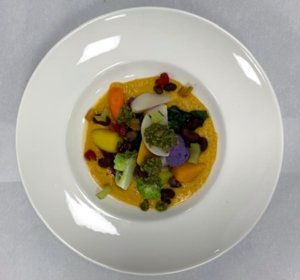
Beef or beet? Plant-based burgers have become increasingly prolific over the past few years.
Both the Golden Globes and Screen Actors Guild (SAG) served meatless meals during their awards ceremonies this January, providing all-vegan dishes like golden beet soup and Romano bean salad to Hollywood glitterati, which drew mixed reactions from the crowd.
While both organizations had announced the change just days before the ceremonies and received praise for the menus from actors like Joaquin Phoenix — a practicing vegan since age three — other guests weren’t as pleased. In an interview with “Access Hollywood,” Golden Globes host Ricky Gervais commented on the hypocrisy of having guests “arriving all in separate limos to have some veg” from an environmental standpoint. There was also backlash on social media, with Twitter users claiming that the lack of meat was too extreme.

Tracy Stuckrath
Meatless meals also have been served up at lower-profile events — like Convening Leaders in San Francisco in early January, where Monday’s networking lunch, sponsored by IMEX, featured locally sourced vegetable mole and seasonal greens. There are a number of good reasons why event organizers are opting for more meatless menus — from reducing the carbon footprint of their events to lowering their F&B costs to offering healthier options for their attendees — but it’s not always easy to get attendees to stomach the idea. Tracy Stuckrath, CSEP, CMM, CHC, CFPM, whose company thrive! meetings and events specializes in F&B consulting for the meetings industry, said that transparency and communication before your event is critical to attendee buy-in. “It’s figuring out a balance of how you communicate it, and communicate it in advance,” Stuckrath told Convene. An ideal situation, Stuckrath said, would be if the meal was offered at an optional part of the event, so guests can choose to participate or not.
For those looking to add more meatless options to their next event, Stuckrath shared a few tips on how to make it more palatable for omnivores and their meat-loving peers.
Names Matter

Vegetable mole was served at Convening Leaders.
One thing to keep in mind is to avoid inadvertently giving the wrong impression when labeling or describing food items. Stuckrath used “vegan chicken pot pie” as an example. For attendees who primarily eat meat, “vegan chicken” might be misleading or confusing. “You need to make it comfortable and familiar,” said Stuckrath, who recommends swapping in the term “plant-based” for vegan or vegetarian. “Chicken pot pie in some respects is not transparent when you say it’s vegan because it’s really not chicken.”
Stuckrath said that using the term “plant-based” makes your menu sound more neutral, due to negative connotations the word “vegan” may hold for some attendees. “The word ‘vegan’ is kind of very ostracizing to people and using ‘plant-based’ [instead] is a lot easier for people to swallow,” Stuckrath said.
Be Flexible
Another option Stuckrath recommended for event planners was to not forgo meat on the menu entirely. Instead, Stuckrath said to find creative ways to reduce its presence through “flexitarian” and “reducetarian” menus.
A flexitarian menu is mostly plant-based, with meat or animal byproducts being a side dish instead of the centerpiece. With a flexitarian menu, “plant-based items are the focus of the meal,” Stuckrath said, adding that by doing this, you can introduce plant-based items more gradually, instead of going cold turkey with an entirely meatless menu.
While a flexitarian menu is focused on plant-based menu items, a reducetarian menu focuses on reducing the amount of overall meat consumption. To go the reducetarian route, Stuckrath suggested including menus with blended foods. One example? A burger mixed with vegetables such as mushrooms, to cut back on the ounces of beef consumed.
And instead of attendees being served nine ounces of protein in a sitting, Stuckrath said that three or four ounces per person is plenty. “When you typically walk through a buffet, you see everybody pretty much taking all three [proteins], which is ridiculous. Looking at how you can cut that one protein out and make it a vegan protein is great.”
Naturally, there’s one segment of your audience that will welcome having more meatless options: vegans and vegetarians, whose numbers continue to grow: U.S. consumers identifying as vegan increased from 1 percent to 6 percent between 2014 and 2017, and while that is still a small percentage of consumers overall, that growth represents a 600-percent increase, as data analytics firm GlobalData pointed out.
Stuckrath said that offering meatless options isn’t just healthy for attendees — it’s also healthy for your bottom line. “You have to figure out because of the number of people that are vegan and vegetarian or plant-based these days, it’s an opportunity to bring in new revenue.”
